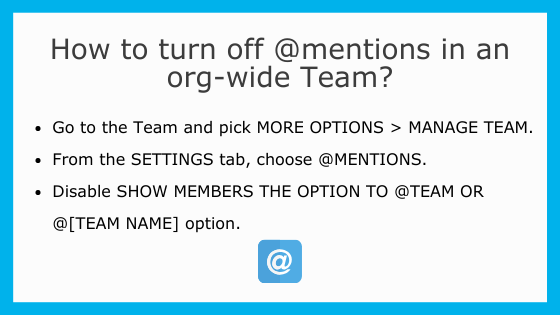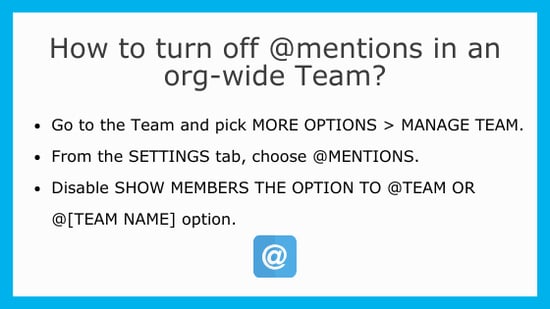By streamlining their resources and processes, small and medium-sized businesses have the potential to increase their productivity. Achieving a strong level of communication and collaboration among employees is crucial. Microsoft Teams is a platform that can help streamline many of your processes and revamp how you collaborate. Using Microsoft Teams, you can set up an organization-wide team or channel to handle your communications. Though it sounds simple and effortless, it's important to know how to set it up precisely and understand each of the significant factors. That said, let's take a look into possibilities that creating organization-wide Microsoft Teams channel can offer.
Content-
- Overview of Organization-Wide Teams
- Steps to Create A Company-Wide Team
- Users Included and Excluded
- Best Practices to Set Up A Company-Wide Team
- How to Manage Team Moderation
- Other Options You Should Know
Overview of Organization-Wide Teams
The best thing about an organization-wide team is that it will be like a public team within your organization. A user's membership gets automatically updated along with the team's active directory. Users get added and removed automatically as they join and leave the organization. However, only global admins have the right to create a company-wide team. You should have less than 5,000 users in your organization to get the most benefit from this. Furthermore, you can create up to 5 company-wide teams in a tenant. If your organization meets all these requirements, then the global admins will get to see an ‘Org-wide’ option while choosing the Build a team from scratch option as part of setting up a team.
Steps to Create A Company-Wide Team
With a company-wide team you can perform 3 main tasks: Communicate with all employees in your organization, store files, and schedule meetings. Here are the steps you need to follow for creating an org-wide Team in Microsoft Teams:
- Go to Microsoft Teams.
- Choose ‘Join or create a team’ option and select ‘Create a team’.
- Enter the suggested team name and description in the field provided.
- Click on the ‘Privacy’ drop-down and pick ‘Org-wide – Everyone in your organization will be automatically added’.
- Choose ‘Next’. You have now created a company-wide team.
- You can now add a welcome message to the entire team.
- When your employees enter this team, they will see this message.
- Use the ‘Files’ tab to add documents for everyone to see.
- Use the ‘Open in SharePoint’ tab to see the rest of the site in SharePoint.
- Click on ‘Add cloud storage’ to add more sites to the team.
- The ‘Wiki’ tab is for adding notes and sharing other company-related information.
- Click on the ‘+’ icon to add more relevant apps to the team.
Let’s now learn which users are included and excluded in these teams and how!
Users Included and Excluded
As you might have guessed by now, all active users in your organization will be added as members of the team by default. Global Admins will be set as team owners, and unlicensed users will also be part of the team. There are a few types of user accounts that are automatically excluded from this team - block accounts, service accounts, guest users, and room or equipment accounts. Accounts with a shared mailbox are also not included in the company-wide team.
When your organization’s directory gets updated with new active users or old, unused accounts are disabled, the changes will also reflect in the company-wide team as well. Global Admins can add or remove a user, but users cannot leave the team on their own.
Best Practices to Set Up A Company-Wide Team
As part of utilizing the org-wide team to the best extent, you could follow some best practices that are tried and tested.
- Let only Team Owners post to the general channel to eliminate unnecessary noise.

- Disable the @mentions to avoid overloading to mentions.

- Auto-favorite channels for the team.

How to Manage Team Moderation
It is essential to consider the team moderation requirement seriously. When you do this right, you will see improved employee engagement within your organization. Team owners have moderator capabilities by default. Think about which team members would be suitable as moderators and assign them the rights as needed. Moderators will have capabilities like who can reply to channel messages, adding/removing moderators, who can start a post, etc. Moreover, they can decide whether connectors and bots can submit channel messages. While removing accounts that are not relevant anymore or inactive, ensure that you are using Teams to perform that action.
Other Options You Should Know
You can also create company-wide teams without using Teams client. However, they aren’t as easy as it is in Teams. You can use PowerShell to create an org-wide team when needed. It is also possible to convert an existing team to a company-wide team. To perform this action, you should be a Global Admin. To do that go to the team name and choose More Options. Click on Edit Team and pick the Org-wide option.
Having a company-wide Microsoft teams channel gives you the privilege and efficiency to communicate and collaborate with your entire organization in one place. Use this option sensibly to make communication easy and effortless. Subscribe to our blog to read more blogs on employee engagement and productivity.
Book a Live demo
Schedule a live demo of Dock 365's Contract Management Software now.

Written by Alex K Joseph
Alex Joseph is a Digital Marketing Strategist with explicit knowledge in Content Marketing and Microsoft Technologies. A writer by day, Alex is a night owl and a DIYer. Alex's theory is to make businesses achieve success with modern solutions and smart exploitation of resources.







